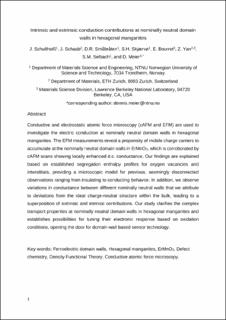| dc.contributor.author | Schultheiß, Jan | |
| dc.contributor.author | Schaab, Jakob | |
| dc.contributor.author | Småbråten, Didrik Rene | |
| dc.contributor.author | Skjærvø, Sandra Helen | |
| dc.contributor.author | Bourret, Edith | |
| dc.contributor.author | Yan, Zewu | |
| dc.contributor.author | Selbach, Sverre Magnus | |
| dc.contributor.author | Meier, Dennis Gerhard | |
| dc.date.accessioned | 2021-02-15T11:38:50Z | |
| dc.date.available | 2021-02-15T11:38:50Z | |
| dc.date.created | 2020-12-01T15:28:36Z | |
| dc.date.issued | 2020 | |
| dc.identifier.issn | 0003-6951 | |
| dc.identifier.uri | https://hdl.handle.net/11250/2728063 | |
| dc.description.abstract | Conductive and electrostatic atomic force microscopy (cAFM and EFM) are used to investigate the electric conduction at nominally neutral domain walls in hexagonal manganites. The EFM measurements reveal a propensity of mobile charge carriers to accumulate at the nominally neutral domain walls in ErMnO3, which is corroborated by cAFM scans showing locally enhanced direct current conductance. Our findings are explained based on the established segregation enthalpy profiles for oxygen vacancies and interstitials, providing a microscopic model for previous, seemingly disconnected observations ranging from insulating to conducting behavior. In addition, we observe variations in conductance between different nominally neutral walls that we attribute to deviations from the ideal charge-neutral structure within the bulk, leading to a superposition of extrinsic and intrinsic contributions. Our study clarifies the complex transport properties at nominally neutral domain walls in hexagonal manganites and establishes the possibility to tune their electronic response based on oxidation conditions, opening the door for domain-wall-based sensor technology. | en_US |
| dc.language.iso | eng | en_US |
| dc.publisher | American Institute of Physics | en_US |
| dc.title | Intrinsic and extrinsic conduction contributions at nominally neutral domain walls in hexagonal manganites | en_US |
| dc.type | Peer reviewed | en_US |
| dc.type | Journal article | en_US |
| dc.description.version | acceptedVersion | en_US |
| dc.source.journal | Applied Physics Letters | en_US |
| dc.identifier.doi | 10.1063/5.0009185 | |
| dc.identifier.cristin | 1854929 | |
| dc.relation.project | Norges teknisk-naturvitenskapelige universitet: Outstanding Academic Fellow Program | en_US |
| dc.relation.project | Norges forskningsråd: 275139 | en_US |
| dc.relation.project | Norges forskningsråd: 231430 | en_US |
| dc.relation.project | Norges teknisk-naturvitenskapelige universitet: Onsager Fellowship Program | en_US |
| dc.description.localcode | © 2020. This is the authors' accepted and refereed manuscript to the article. The final authenticated version is available online at: http://dx.doi.org/10.1063/5.0009185 | en_US |
| cristin.ispublished | true | |
| cristin.fulltext | postprint | |
| cristin.qualitycode | 2 | |
